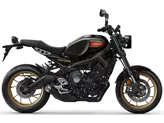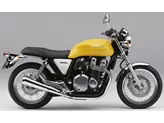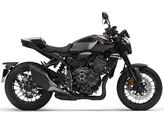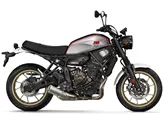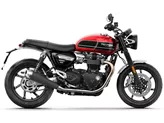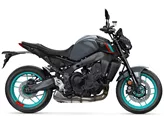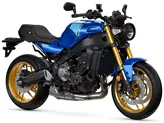Yamaha XSR900 2018 vs. Kawasaki Z900 RS 2018

Yamaha XSR900 2018

Kawasaki Z900 RS 2018
Vue d’ensemble - Yamaha XSR900 2018 vs Kawasaki Z900 RS 2018
The Yamaha XSR900 2018 and the Kawasaki Z900 RS 2018 are both naked bikes with similar engine types and displacements. However, there are several key differences between the two models.
In terms of engine power, the Yamaha XSR900 has a slight advantage with 115 HP compared to the Kawasaki Z900 RS's 111 HP. The Yamaha also has a lower torque of 87.5 Nm compared to the Kawasaki's 98.6 Nm. Both bikes have liquid cooling and similar suspension systems, with upside-down telescopic forks in the front and swing arm suspension with a monoshock in the rear.
One notable difference is in the chassis. The Yamaha XSR900 has an aluminum frame with a twin tube design, while the Kawasaki Z900 RS has a steel frame with a tubular design. This could potentially affect the weight and handling of the bikes.

Yamaha XSR900 2018
In terms of braking, both bikes have double disk brakes in the front with similar diameters. However, the Kawasaki Z900 RS offers additional advanced rider assistance systems such as ABS, ride by wire, and traction control, which the Yamaha XSR900 lacks.
In terms of dimensions and weights, the Yamaha XSR900 has a slightly shorter wheelbase of 1440 mm compared to the Kawasaki Z900 RS's 1470 mm. The seat height of the Yamaha is also slightly lower at 815 mm compared to the Kawasaki's 835 mm. However, the Kawasaki Z900 RS is significantly heavier with a kerb weight of 215 kg compared to the Yamaha XSR900's 191 kg. The Kawasaki also has a larger fuel tank capacity of 17 liters compared to the Yamaha's 14 liters.

Kawasaki Z900 RS 2018
When it comes to strengths, the Yamaha XSR900 is praised for its extremely sporty and rev-happy engine, excellent brakes, and pleasant seating position. It is also noted for its high-quality workmanship and price-performance ratio. On the other hand, the Kawasaki Z900 RS is commended for its powerful and smooth engine, good looks, comfortable seating position, and balanced handling. It is described as easy to ride and not nervous or ponderous.
In terms of weaknesses, the Yamaha XSR900 is criticized for its almost too direct response and the retro style not being thought through to the last detail. The Kawasaki Z900 RS, on the other hand, is noted for lacking a shift assistant, being heavier than other retro bikes in its class, having a seat that is too soft for long tours, and lacking wind protection.
Overall, both the Yamaha XSR900 2018 and the Kawasaki Z900 RS 2018 have their strengths and weaknesses. The Yamaha offers a more sporty and rev-happy experience, while the Kawasaki provides a powerful and smooth ride with a more comfortable seating position. Ultimately, the choice between the two models will depend on the rider's preferences and priorities.
Caractéristiques techniques Yamaha XSR900 2018 par rapport à Kawasaki Z900 RS 2018
Avantages et inconvénients en comparaison
Avantages et inconvénients en comparaison
Yamaha XSR900 2018

La Yamaha XSR900 est une illusion d'optique classique - avec son phare rond, son réservoir anguleux et son feu arrière rapporté, elle passe clairement pour une moto rétro. Mais ce n'est pas un hasard si ses performances rappellent celles de la puissante moto tout terrain de classe moyenne Yamaha MT-09, car celle-ci constitue la base extrêmement sportive de la XSR900. Le moteur est donc une merveille et les freins sont très puissants. En ce qui concerne le châssis, les techniciens n'exagèrent heureusement pas, la XSR900 offre suffisamment de confort et la position d'assise droite est plus confortable que ne le laisserait supposer le moteur puissant. Dans la catégorie des motos rétro, la XSR900 est néanmoins l'un des modèles les plus sportifs.
Kawasaki Z900 RS 2018

Son quatre cylindres est doux comme de la soie et fournit en même temps suffisamment de puissance pour faire sourire sous le casque. De plus, elle est très facile à déplacer, ce qui devrait en faire un excellent véhicule de banlieue au quotidien et un funbike culte le week-end. L'optique trouve le juste milieu entre le design classique et les détails modernes pour former un ensemble rétro cohérent, qui est en même temps un hommage digne de l'histoire de Kawasaki. C'est une superbe nakedbike à l'allure élégante.
Comparaison des prix Prix moyen du marché Yamaha XSR900 vs Kawasaki Z900 RS
There are a few key differences between a Yamaha XSR900 2018 and a Kawasaki Z900 RS 2018. In terms of price, the actual average price of a Kawasaki Z900 RS 2018 is about 58% higher. A Yamaha XSR900 2018 experiences a loss of 180 USD in one year and 120 USD in two years of ownership. This is offset by a loss of 900 USD and 1,070 USD for a Kawasaki Z900 RS 2018. Compared to Kawasaki Z900 RS 2018 there are less Yamaha XSR900 2018 bikes available on the 1000PS.de Marketplace, specifically 4 compared to 28. It takes less time to sell a Yamaha XSR900 with 123 days compared to 154 days for a Kawasaki Z900 RS. Since model year 2016 1000PS.de editors have written 30 reviews for the Yamaha XSR900 and 26 reviews for the Kawasaki Z900 RS since model year 2018. The first review for the Yamaha XSR900 was published on 11/25/2015 and now has more than 17,600 views. This compares to more than 63,700 views for the first review on Kawasaki Z900 RS published on 9/6/2017.













